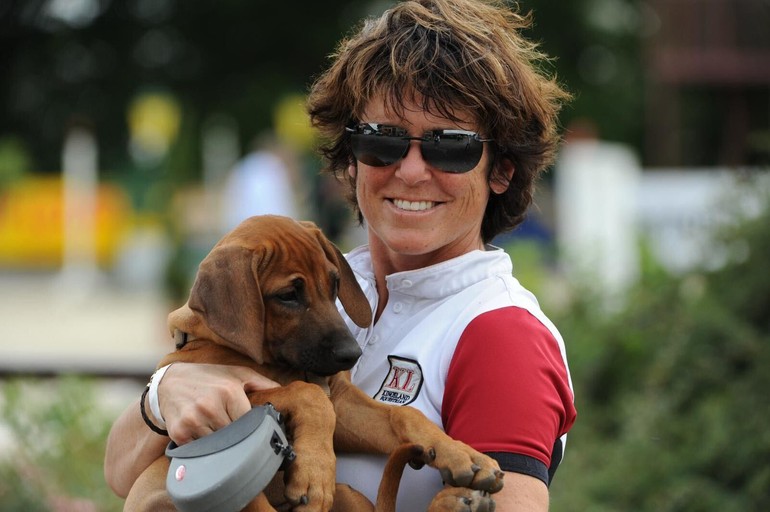Gastric ulcers in horses are not uncommon. According to scientific studies and observations, the frequency of gastric ulceration in horses used for leisure riding, breeding, sports, and racing is between 60 to 90 percent. This means that, essentially, every second horse will experience stomach problems at some point in its life.
At Equine74, we deal with this topic on a daily basis. We receive calls and emails from riders and horse owners who have questions about the causes, effects, symptoms, treatments, cures, and prevention of gastric ulcers. That is why we aim to provide answers and present the information in a simple, clear, and easily understandable way.
Today, I am especially excited because we are meeting with Erin Charaklis, a U.S. show jumper who runs a small but excellent jumping stable in the far north of Germany, in Schleswig-Holstein.
Christian Dietz:
We are sitting in different time zones. It is currently 24 degrees Celsius here in Ocala, Florida, while Erin is in Schleswig-Holstein, where it is cold and rainy.
Erin, I would like to talk about your career and your experience with horses. You have worked with some incredibly well-known mares—Belladonna, Ceremony, and Riverland. These Holsteiner mares have competed in the Olympics, won Nations Cups, achieved World Cup victories, and secured placements in the biggest jumping competitions worldwide. All of them have been in your stable. I just mentioned these three because, for me, they are the most famous ones.
How did you discover them? Was it by chance, or were you specifically looking for such horses? Take Belladonna, for example—when you first saw her, did you immediately think of Meredith Michaels-Beerbaum, or how did that happen?
Erin Charaklis:
No, with Belladonna, I became involved when she was four years old, together with another colleague of ours. She had just been started under saddle, actually abroad, and then she came back to Germany. She was completely raw—she could do nothing, she wasn’t ready for jumping courses, she was completely untrained.
Through free jumping and trial rides, we tested her, but only within a limited framework. We had her do small jumps, verticals, and that was about it. That was at four years old, and then we invested in her, and she immediately came to my stable. Her first competition was probably nine months later. I had to start completely from scratch with her.
She was sold at the end of her six-year-old season. So, I had her in my stable for two full years before she moved on to Beerbaum’s stable.
Christian Dietz:
What was she like? Did you immediately have a great feeling riding her? Did you instantly feel that she was a horse with exceptional potential?
Erin Charaklis:
She was an absolute standout, something I have rarely experienced again. Even at four years old, it was clear that she had everything that makes a truly exceptional horse. She was strong in character, definitely, but physically, she was not the typical athletic type. She was relatively square, had a long back, a slightly short neck—it wasn’t the type of horse I would usually buy.
But her jumping ability, the way she moved, and her reaction over the jumps were extraordinary. I remember telling my partner at the time, "She looks difficult, but you just can’t pass on a horse like this. If you see a horse like this and don’t buy it, then you might as well not buy anything at all." It wasn’t even a question. The real question was: how would her training develop, how long would it take, and how could I get her to work with me? Those were the risks. But her jumping quality was never in doubt—it was exceptional from the start.
Equine 74 Gastric - Make your Horse feel happy inside! Natural acidbuffer, optimized pH-Level in horses stomach and gut that helps for better performance and satisfaction without compromise. Because good for your horse should als mean good for you! Ready for a free sample? If you are from the EU, order here. US samples are available now! Order them directly in the US shop.
Christian Dietz:
The second mare I wanted to talk about is Ceremony. She was on the spring auction, if I recall correctly?
Erin Charaklis:
No, Ceremony was owned together with the breeders Jochen Aspach and his daughter Deike Aspach. I worked with them on her, and I trained her until she was sold. Ceremony was not at an auction.
Christian Dietz:
Okay, I got that wrong. So, she was bred by them and then came to you at the end of her four-year-old season, beginning of her five-year-old season?
Erin Charaklis:
Yes, exactly.
Christian Dietz:
And she was later sold to Laura Kraut, I believe?
Erin Charaklis:
Yes, Laura Kraut bought her directly from me and had her for the rest of her career.
Christian Dietz:
What kind of horse was Ceremony in terms of personality?
Erin Charaklis:
Ceremony was also a very strong mare, but a very good one. She wanted to do her job, but she had strong opinions and a lot of energy. Managing that energy at four and five years old was definitely a challenge.
But she was an honest horse, just like Belladonna, even with her quirks. You could tell that she wanted to be a sport horse. She had a great character, but she was strong-willed. She also had physical challenges that needed to be improved through training. She was very unstable as a young horse and needed specific training to develop her body and gain strength.
Christian Dietz:
When we talk about exceptional horses that compete at the highest level, talent is obviously there. But what about character? You have mentioned it multiple times—it seems very important to you. How do you see the role of willingness and intelligence? When you look at a four-year-old horse, can you already recognize its work ethic and intelligence? Do you feel it, or do you see it?
Erin Charaklis:
I believe that young horses have a lot of innate potential, but their intelligence needs to be nurtured. Just like when humans go to school or university, it’s not just about gaining knowledge—it’s about learning how to learn.
Horses that come into a structured training system at four or five years old are taught a methodical approach. The key is to provide fair challenges, where they can problem-solve and get rewarded when they make the right choices. Over time, they start to understand that every challenge has a solution.
When a horse is repeatedly put in situations where it cannot find a solution, that’s when panic and frustration set in. Some horses shut down completely and stop trying. That’s when people label them as "dull" or "not intelligent." But in reality, they may have just given up because they never experienced structured problem-solving.
Christian Dietz:
We are, after all, a supplement manufacturer, so I find the topic of feeding very exciting. Do you also start in the morning with hay, as most stables do, feeding it first at 6 AM, or how do you structure it?
Erin Charaklis:
Yes, of course, it’s well known that feeding hay first before concentrated feed is very important for stomach health. Absolutely. Hay rather than haylage is preferred, also for gastric health.
Christian Dietz:
And do you feed concentrated feed twice or three times a day? Do you also include oats?
Erin Charaklis:
Three times. And as much as possible, I try to avoid grain. I prefer to feed without oats because my horses already have a higher percentage of blood. I prefer grain-free muesli, and for some horses, I go completely grain-free. I find they don’t need it for their temperament, and I’m not worried about removing grain from their diet if they already have enough energy. Oats are a good energy source, but if they have enough energy, the question is whether additional grain is necessary.
Christian Dietz:
Do your horses also receive hay overnight? When is the last time you give them hay—afternoon or evening?
Erin Charaklis:
Most years, we have always used hay nets before finishing up in the evening, placing them in the stalls, and then during the night check, we hang more hay nets so the horses still have something to eat around 8 or 9 PM. This way, they never go too long without forage.
Christian Dietz:
You’ve been feeding Equine74 Gastric for quite some time. We partnered about a year ago, but you were already using it before. How did you first discover Equine74 Gastric?
Erin Charaklis:
I remember it exactly. It must have been about eight or nine years ago—just around when you started, I believe. I heard about it from an osteopath. We had always been very aware of gastric health, and she had some experience with it and recommended it to me. Since then, I’ve been feeding it consistently. Even before we started working together, I was already a long-time user.
Christian Dietz:
Do you give it preventatively to all your horses, or only to those showing symptoms?
Erin Charaklis:
No, because exactly as you said earlier, my experience is that some horses show clear signs of stomach problems—some leave food in the trough, others soak their hay in water. There are clear symptoms like loose manure, crib-biting, or grinding their teeth. But many don’t show any signs at all.
Honestly, I give it to all of my own horses, even if they don’t show obvious symptoms. Because when you hear statistics that 90% of horses may have some level of gastric irritation, then even horses that seem fine could still benefit. Even if they don’t have ulcers, they may have stomach lining irritation, which is also unpleasant.
Christian Dietz:
We conducted a study on the effectiveness of Equine74 Gastric. One key factor is balancing stomach acid. Even if horses have access to forage all day, they can still develop gastric ulcers due to hormone imbalances involving prostaglandins and cortisol. If the reproduction of the gastric mucosa is disrupted, the stomach lining becomes unprotected, leading to inflammation or ulcers.
An important aspect of feeding Equine74 Gastric is that it helps to increase the pH level in the stomach. Normally, horses have a very acidic stomach environment with a pH around 2. When they chew, their saliva and feed help raise the pH to around 4 before it enters the intestine. But if this doesn’t happen, the overly acidic content can cause problems further down in the digestive tract.
Erin Charaklis:
Yes, and that’s exactly why I believe a lot of horses have undiagnosed issues. Because even if you do a gastroscopy, it only checks the stomach. But problems can also be in the small intestine, where the scope can’t reach. And those issues are just as painful.
A vet might tell you that your horse’s stomach looks fine, so you don’t feed anything for stomach health, but the horse might still be struggling with intestinal irritation. That’s why, for all these reasons, I continue to feed Equine74 Gastric even when I don’t see obvious symptoms in a horse.
Christian Dietz:
That’s also where the topic of Leaky Gut comes in, which is a big issue. Here in America, I’ve noticed that awareness of Leaky Gut Syndrome in horses is much higher than in Europe. This year, we are working on a new Leaky Gut product, specifically targeting this issue. I’d love for you to try it as soon as it is on the market.
Erin Charaklis:
That sounds really exciting. I’d be happy to try it!
Christian Dietz:
Finally, do you have a tip for horse owners on how to build trust and confidence in their horses?
Erin Charaklis:
The worst thing for a horse’s confidence is being overwhelmed—whether physically or mentally. Horses don’t know our competition goals. They only know what they experienced yesterday.
It’s important to be mindful, take time, and structure training fairly. The key to building trust is patience and setting horses up for success.
Christian Dietz:
Thank you, Erin. This was a fascinating conversation.
Erin Charaklis:
Thank you, Christian! I enjoyed it too.
Interested in learning more about Equine 74 Gastric? Click here for more information, or feel free to text or call Christian Dietz, CEO of Equine 74:
Europe: +49 172 5184099
USA: (352) 207 6857
You can also meet Equine 74 in Ocala—we look forward to welcoming you!










